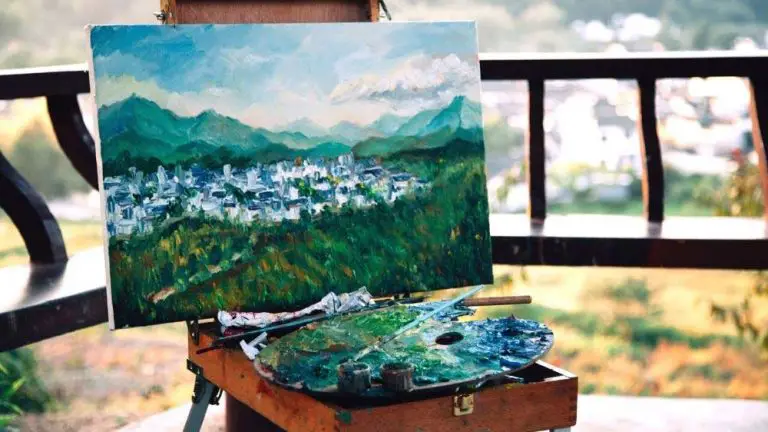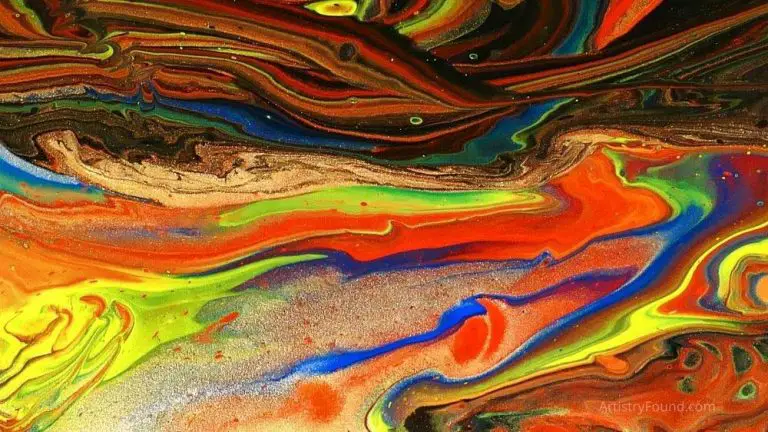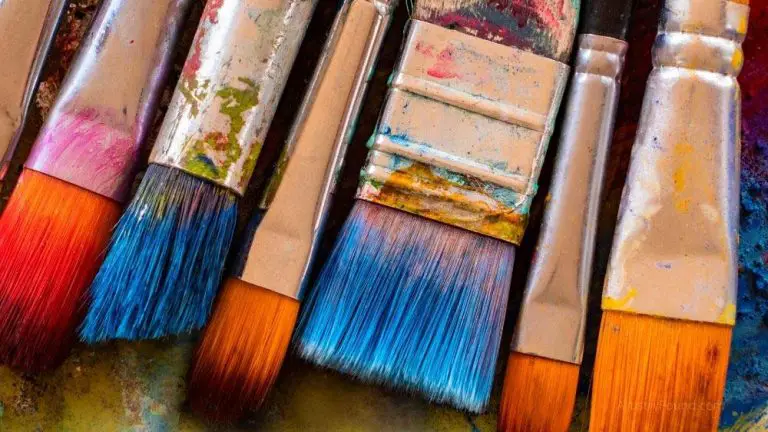Should Artists Date Their Paintings? (What You Need to Know)
In the art world, there has been a serious debate going on for decades (if not longer) about whether an artist should date their paintings or not. Some artists see omitting the date as unprofessional and dishonest, while others feel that dating a painting can prevent the artwork from being sold. Both sides seem to have very strong opinions. So, should artists date their paintings?
You should not add a date to the front of your paintings because it is distracting to the artwork, and may limit its sales potential. If you feel you must date your painting, you can add the date discreetly by either blending it in with the painting itself, or by choosing to date the back of the canvas instead.
In this article, I’ll discuss both sides of the argument over whether you should or should not date your paintings, and the best options for dating your art if you choose to go that route.

(This article may contain affiliate links and I may earn a commission if you make a purchase)
Examine Your Motivation For Adding a Date To Your Paintings
The first question you should ask yourself involves why you would want to add a date to your painting in the first place. Whether or not you are a famous artist, you should know that dating your work is not mandatory. Lots of famous artists from history have chosen to either date or not to date their work, and others vary from painting to painting.
If you have created the art solely for yourself, there really is not much harm in adding a date to the painting. This is especially true when you paint something for a friend or family member. Your loved one will probably find it nice and nostalgic to look back on the art and remember what year and for what occasion you gifted them the painting.
If you are not looking to sell your art or place your work in a gallery, auction house or museum, you might date and even title the work on the back of the canvas. You obviously do not want to distract from the overall look of the painting. If you must include the date in addition to your artist signature on the front, try to keep it as subtle as possible.
Why You Should Add a Date to Your Paintings
Various artists and curators claim there are many benefits to adding a date to your works. Cataloging your visual art with a date can help keep track of your various paintings over the years. Keeping a record like this can come in handy if:
- You are working on a gallery exhibit
- You tend to be forgetful
- You have created a lot of art in a short period
Adding a date to your work can help potential buyers see your process and the progression of your work. Every professional artist goes through different phases and periods in their art work, so cataloging your fine art with a date helps the market, and the world, see how you have developed over your career.
Oftentimes world events and social circumstances can have a powerful influence on artists. For instance, Picasso’s “Guernica” is a haunting work of art based on the bombings at Guernica and how they affected the world and him personally in the 1930s. The painting is widely known as one of the most famous anti-war paintings from the 20th century.
Art expresses emotions that words cannot. It can take time—years, even—for a particular painting to be fully appreciated by the public at large. If a painter chooses not to date their work for whatever reason, this could possibly prevent people from seeing important reactions to world and social events within their intended contexts.
Why You Should Avoid Dating Your Paintings
Many collectors do not find it relevant what date a piece is created, and worry that visible dates distract from both the art and their potential long term investment in the piece. Numerous artists agree that adding a date is not only unnecessary, but it could also potentially be harmful to your career.
Many famous artists and painters have a catalog of some sort, separate from their art, that keeps track of certain details about their specific paintings, and this written catalog would be a more approprate place to date the work.
You can keep a personal file or even an online Catalogue Raisonné to help keep certain aspects of your art organized without the need to write the date on each piece of art physically. These Catalogues Raisonnés can be referenced by you or anyone else to find details about your art, such as:
- Medium used
- Date of the art
- Provenance or history of ownership
- Title(s) of the painting
If you do choose to date your work, you have to accept certain risks that may come along with doing so. For example, if your art is for sale by an art dealer or gallery, but has an older date on it, people could think there is something wrong with the painting and may avoid purchasing it. This could be true regardless of how much they actually like the work.
Art galleries also tend to shy away from displaying older works since they want to showcase items that are more fresh and recent. If you are not a well-known artist and the work you are showing is older, this consideration could reflect especially poorly on the art itself.
Dating vs. Not Dating Your Artwork: Do The Benefits Outweigh the Risks?
No matter which way you happen to side in regards to this specific debate, you must decide if you are willing to take the potential risks that come with either adding or omitting a date. Consider that casual art buyers only want decorative art to accent a room and do not want to see old dates on the front of those pieces.
It is also worth mentioning that if you have fewer works you have created in one particular year, this could create a sort of higher demand based on a low supply. In this circumstance, adding dates to your work could lead to exclusivity for that year’s paintings, increasing their value and turning out positively for you and your career.
The last thing you would want as an artist is for your work to be rejected simply because of the year in which it was completed. Not every painting speaks to every person that sees it. It may take a few years to find the proper home for your work, primarily if the market is struggling at the time.
There is not a right, one-size-fits-all solution to this complicated subject in the art community. Not every artist will make it big in the art world as a household name. Each artist must decide for themselves if they want to add a date to their work and if the benefits of doing so will overcome any future negative impact.
If Dating Your Paintings, Use Consistent Behaviors
It is not necessarily a form of artistic sacrilege to add a date to your painting, even if you place the date on the front of the work, next to the artist’s signature. There are simple ways you can lessen the impact your signature may have on the piece.
- Do not mix mediums
- Hide the date within the painting
- Use consistent signatures and dates to prevent counterfeiters
(Note: While signature consistency is best, artists can and do change their signatures over the course of their careers).
There is some controversy over whether signing and dating your painting on the front can distract from the most important part, which is, of course, the artwork itself. When you mix your mediums by dating a chalk pastel with a ballpoint pen, for example, you only distract more from the picture.
Some artists do their best to treat signing and dating their work as a form of “Where’s Waldo?” If the viewer or potential buyer does not have to really search to find the signature and date on the front of your work, you are probably doing it wrong. It should feel as much a part of the painting as the artwork itself.
You will want to be consistent with the way you sign and date your painting. Doing this helps to add an air of authenticity. In addition, if you regularly change the location or style of your artists signature and date, it is easier for scam artists to create fraudulent work in your name.
Explore Different Ways to Add the Date to Your Paintings
Adding a signature and date to an acrylic or oil painting is as simple as using a small brush to apply with a similar medium. It is much like signing your name with any other writing tool. You can also use the opposite end of your brush to scratch the date and signature into the still-wet paint. It is not recommended to scratch into dry paint.
There are countless ways to sign and date your painting, but some of the more common and interesting ways are to:
- Use a small, ultra-thin brush called a signature brush
- Press a finger in the still-wet paint and scratch the date with a fingernail
- Sign and date the work in pencil or pen and then go over it with the medium used
Whenever possible, you should use a color and style to sign and date your painting that will not divert attention from your work. The important thing to remember when signing and dating your art piece is that the words and numbers are visible, but they blend in with the story of your art and do not disturb the viewer’s eye.
Ideas to Sign and Date Watercolor Paintings
Every medium is different, and working with watercolors makes creating a signature or date that blends into the painting more difficult. Here are some ideas for adding a date or signature to a watercolor painting in an unobtrusive way.
Add a Dark Wash of Color
Writing on a watercolor painting can be extremely difficult to do without distracting from the portrait. Watercolor pens (Amazon) do exist, but they have the potential of bleeding into the art, and they easily lose their desired effect.
The easiest way to add your signature to a watercolor painting is first to use a somewhat darker color to wash the area you want to sign and date. This could be part of the painting, or added at the end, provided the darker wash compliments the artwork.
- Add a relatively thick layer of watercolor paint to the paper
- With the blunt end of your brush, write your name and date directly into the wash
- The color will sink deeper into the grooves you make and will continue to get darker and darker
- You can also blot away a little bit of the excess wash, and the date will still be visible
Use a Graphite Pencil
Another way to sign and date your watercolor painting on the front without drawing too much attention is to use a graphite pencil (Amazon). A graphite pencil is less conspicuous than a dark ink pen but will still be easily visible and will not bleed into the watercolor like other mediums might.
You may be wondering why an artist would ever use a pencil of any kind to sign a painting. When applied properly, a graphite signature will not erase away like any typical Number 2 pencil might and instead becomes just as much a part of the painting as the watercolor.
- Begin by signing and dating the painting with the graphite pencil
- Get your paintbrush a little wet with water
- Add a light wash of water to the area that you have signed and dated
- You can blend the watercolors into the signature and date
Although it is customary for an artist to place their signature at the bottom right of the picture, you can sign anywhere that will not be overly distracting to the art. You do not need to press extra hard on the pencil. Just sign and date as you normally would, and the water wash will ensure the signature and date are permanent.
Practice With Maskoid
Another wonderfully soft way to sign and date your work is to use masking fluid. Masking fluid, or maskoid (Amazon), is a tool commonly used by watercolorists to protect certain parts of the paper from colored paint. Maskoid can be applied anywhere on the paper, from large sections with a brush to thin lines with a tipped bottle or dipping pen.
Usually, the artist will wait until the maskoid has dried, paint over the area, and then use an eraser to scratch up the maskoid so they can then paint the leftover white underneath. This method works equally well with acrylic on canvas as it does with watercolor on paper.
Before you start your watercolor, you can use the maskoid to sign and date your painting in a small area. When you have finished painting your masterpiece, you will be left with your signature perfectly etched forever in white, outlined by your painted artwork.
This process may sound a little unorthodox, but it is a beautifully simple way to catalog your work inconspicuously. Perhaps the best part of this is that when using this method, you will never forget to sign and date your art!
Consider Dating the Back of the Painting
The more famous your art gets, the more others will want to see how your style has progressed and evolved. This is why it is best to put your date on the back of the painting. This method of dating your work seems to be the happiest compromise. The date is technically included in the art but is out of sight.
The most popular places to put the date on a painting are:
- On the back of the frame
- On a sticker on the back of the frame
- Directly on the back of the canvas
Keep in mind that paintings can need reframing in the future. If your work becomes highly publicized in subsequent years, the frame may eventually erode and need to be replaced. It would be devastating to lose that signature or date! Along that vein of thought, stickers may not always stay on the frame either and should probably be avoided.
Placing your date on the back of the canvas itself will give you, the artist, peace of mind and ensure that it will not give any adverse bias to the potential sale of your painting. This form of cataloging your work is also the best to ensure that nothing distracts from the overall look of your art.
Many artists will put more than just the date on the back of the painting’s canvas. It is common to include things like the location where the painting was created, a title for the work, and even a short sentiment if the art is dedicated to someone or given as a gift. A whole story can exist on the back of the canvas without an observer ever knowing.
More From Artistry Found:
- Should I Sell My Original Paintings Or Just Prints? (Explained!)
- Do Flower Paintings Actually Sell? (You May Be Surprised!)
- Can You Sell a Painting of a Celebrity? (Explained!)
Final Thoughts
It is intriguing that something as small as writing a date on a painting could result in such a heated debate within the art community. At the end of the day, it’s your artistic expression, you can put the completion date of your work on the front or back of your painting or choose not to include the date at all. Each of these choices will have advantages and drawbacks.
If you feel you must date your work, there are less conspicuous methods that will not draw an observer’s attention away from your piece and still keep the theme of your art front and center. Remember, the way you sign and date your painting will be every bit a part of the portrait as the actual image itself.
Sources:
https://www.nypl.org/about/divisions/wallach-division/art-architecture-collection/catalogue-raisonne
https://www.christies.com/features/8-things-you-can-learn-from-the-back-of-a-painting-10293-1.aspx
https://www.nypl.org/about/divisions/wallach-division/art-architecture-collection/catalogue-raisonne






